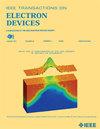Omni 3D: BEOL-Compatible 3-D Logic With Omnipresent Power, Signal, and Clock
IF 2.9
2区 工程技术
Q2 ENGINEERING, ELECTRICAL & ELECTRONIC
引用次数: 0
Abstract
This article presents Omni 3D—a 3-D-stacked device architecture that is naturally enabled by back-end-of-line (BEOL)-compatible transistors. Omni 3D interleaves metal layers with 3-D-stacked nFETs and pFETs. Thus, the signal and power routing layers have fine-grained, all-sided access to the field-effect transistor (FET) active regions maximizing 3-D standard cell design flexibility. This is in sharp contrast to approaches such as back-side power delivery network (BSPDN), complementary FETs (CFETs), and stacked FETs. Importantly, the routing flexibility of Omni 3D is enabled by double-side metal and interleaved metal (IM) for inter- and intracell routing, respectively. In this work, we explore Omni 3D variants (e.g., both with and without the IM) and optimize these variants using a virtual-source BEOL-FET compact model. We establish a physical design flow that efficiently uses the double-side routing in Omni 3D and perform a thorough design technology co-optimization (DTCO) of Omni 3D device architecture on several design points. From our design flow, we projectOmni 3D:与beol兼容的3D逻辑与无所不在的电源,信号和时钟
本文介绍了Omni 3d -一种由后端线(BEOL)兼容晶体管自然支持的3d堆叠器件架构。Omni 3D与3D堆叠的nfet和pfet交织金属层。因此,信号和功率路由层具有细粒度的、全方位的场效应晶体管(FET)有源区域,最大限度地提高了3-D标准单元设计的灵活性。这与后侧供电网络(BSPDN)、互补场效应管(cfet)和堆叠场效应管等方法形成鲜明对比。重要的是,Omni 3D的布线灵活性是通过双面金属和交错金属(IM)实现的,分别用于细胞间和细胞内的布线。在这项工作中,我们探索了Omni 3D变体(例如,有和没有IM),并使用虚拟源BEOL-FET紧凑模型优化这些变体。我们建立了一个有效使用Omni 3D中双面路由的物理设计流程,并在几个设计点上对Omni 3D器件架构进行了彻底的设计技术协同优化(DTCO)。从我们的设计流程来看,与最先进的带有BSPDN的cfet相比,我们的基准电路的能量延迟积(EDP)平均提高了${2.0}}倍,面积平均减少了${1.5}}倍。
本文章由计算机程序翻译,如有差异,请以英文原文为准。
求助全文
约1分钟内获得全文
求助全文
来源期刊

IEEE Transactions on Electron Devices
工程技术-工程:电子与电气
CiteScore
5.80
自引率
16.10%
发文量
937
审稿时长
3.8 months
期刊介绍:
IEEE Transactions on Electron Devices publishes original and significant contributions relating to the theory, modeling, design, performance and reliability of electron and ion integrated circuit devices and interconnects, involving insulators, metals, organic materials, micro-plasmas, semiconductors, quantum-effect structures, vacuum devices, and emerging materials with applications in bioelectronics, biomedical electronics, computation, communications, displays, microelectromechanics, imaging, micro-actuators, nanoelectronics, optoelectronics, photovoltaics, power ICs and micro-sensors. Tutorial and review papers on these subjects are also published and occasional special issues appear to present a collection of papers which treat particular areas in more depth and breadth.
 求助内容:
求助内容: 应助结果提醒方式:
应助结果提醒方式:


